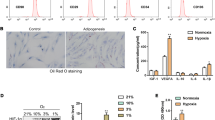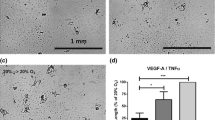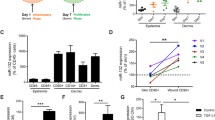Abstract
Angiogenesis is a critical process during human skin wound healing. However, hypoxia might lead to the dysfunction of the cellular interplay of endothelial cells and subcutaneous fibroblasts, resulting in the deregulation of angiogenesis. HIF1A is a key regulatory of the recovery of intracellular homeostasis under hypoxia. In the present study, the detailed role and mechanism of HIF1A in the angiogenesis under hypoxia were investigated. Via bioinformatic analyses on microarray profiles (GSE1041 and GSE17944), solube fms-related tyrosine kinase 1 (sFLT1, also known as sVEGFR1) and miR-210/miR-424 might be involved in HIF1A function on the angiogenesis under hypoxia in human umbilical vascular endothelium cells (HUVECs) and human dermal microvascular endothelial cells (HDMECs). In the present study, we identified sFLT1 as a downregulated gene in response to hypoxia and HIF1A overexpression in HUVECs and HDMECs. sFLT1 overexpression inhibited the capacity of migration and angiogenesis and significantly reversed the inducible effects of HIF1A on the migration and angiogenesis in both cell lines. miR-210 and miR-424 were upregulated by hypoxia and targeted sFLT1 3′-UTR to negatively modulate its expression. HIF1A modulated sFLT1 expression, VEGF signaling, and the migration and angiogenesis in HUVECs and HDMECs via miR-210/miR-424. Regarding the molecular mechanism, HIF1A bound the promoter region of miR-210 and miR-424 to activate their transcription, while miR-210/miR-424 bound sFLT1 3′-UTR to suppress its expression. In summary, HIF1A/miR-210/miR-424/sFLT1 axis modulates the angiogenesis in HUVECs and HDMECs upon hypoxic condition via VEGF signaling.





Similar content being viewed by others
Data availability
The authors confirm that the data supporting the findings of this study are available within the article.
Consent for publication
Not applicable.
References
Singer AJ, Clark RA (1999) Cutaneous wound healing. N Engl J Med 341(10):738–746
Han G, Ceilley R (2017) Chronic wound healing: a review of current management and treatments. Adv Ther 34(3):599–610
Dawes KE et al (1994) Characterization of fibroblast mitogens and chemoattractants produced by endothelial cells exposed to hypoxia. Am J Respir Cell Mol Biol 10(5):552–559
Ke Q, Costa M (2006) Hypoxia-inducible factor-1 (HIF-1). Mol Pharmacol 70(5):1469–1480
Jones V, Grey JE, Harding KG (2006) Wound dressings. BMJ 332(7544):777–780
Semenza GL (2012) Hypoxia-inducible factors in physiology and medicine. Cell 148(3):399–408
Stroka DM et al (2001) HIF-1 is expressed in normoxic tissue and displays an organ-specific regulation under systemic hypoxia. FASEB J 15(13):2445–2453
Rezvani HR et al (2011) HIF-1alpha in epidermis: oxygen sensing, cutaneous angiogenesis, cancer, and non-cancer disorders. J Investig Dermatol 131(9):1793–1805
Zhang X et al (2013) Wound healing improvement with PHD-2 silenced fibroblasts in diabetic mice. PLoS ONE 8(12):e84548
Tonnesen MG, Feng X, Clark RA (2000) Angiogenesis in wound healing. J Investig Dermatol Symp Proc 5(1):40–46
Toksoy A et al (2007) Biphasic expression of stromal cell-derived factor-1 during human wound healing. Br J Dermatol 157(6):1148–1154
Kendall RL, Thomas KA (1993) Inhibition of vascular endothelial cell growth factor activity by an endogenously encoded soluble receptor. Proc Natl Acad Sci USA 90(22):10705–10709
Suarez Y, Sessa WC (2009) MicroRNAs as novel regulators of angiogenesis. Circ Res 104(4):442–454
Liu H et al (2018) LncRNA XIST/miR-34a axis modulates the cell proliferation and tumor growth of thyroid cancer through MET-PI3K-AKT signaling. J Exp Clin Cancer Res 37(1):279
Li L et al (2018) The role of lncRNA XIST/miR-211 axis in modulating the proliferation and apoptosis of osteoarthritis chondrocytes through CXCR4 and MAPK signaling. Biochem Biophys Res Commun 503(4):2555–2562
Jones WS et al (2012) Alteration in angiogenic and anti-angiogenic forms of vascular endothelial growth factor-A in skeletal muscle of patients with intermittent claudication following exercise training. Vasc Med 17(2):94–100
Yang M et al (2017) Role of the JAK2/STAT3 signaling pathway in the pathogenesis of type 2 diabetes mellitus with macrovascular complications. OncoTarget 8(57):96958–96969
Goldman C et al (1998) Paracrine expression of a native soluble vascular endothelial growth factor receptor inhibits tumor growth, metastasis, and mortality rate. Proc Natl Acad Sci USA 95(15):8795–8800
Ziche M et al (1997) Nitric oxide synthase lies downstream from vascular endothelial growth factor-induced but not basic fibroblast growth factor-induced angiogenesis. J Clin Investig 99(11):2625–2634
Takahashi H, Shibuya M (2005) The vascular endothelial growth factor (VEGF)/VEGF receptor system and its role under physiological and pathological conditions. Clin Sci (Lond) 109(3):227–241
Daubman S (2010) MicroRNAs in angiogenesis and vascular smooth muscle cell function. Circ Res 106(3):423–425
Pourrajab F et al (2015) MicroRNAs; easy and potent targets in optimizing therapeutic methods in reparative angiogenesis. J Cell Mol Med 19(12):2702–2714
Li J et al (2015) LncTar: a tool for predicting the RNA targets of long noncoding RNAs. Brief Bioinform 16(5):806–812
Shafighi M et al (2012) The role of androgens on hypoxia-inducible factor (HIF)-1alpha-induced angiogenesis and on the survival of ischemically challenged skin flaps in a rat model. Microsurgery 32(6):475–481
Yu X et al (2016) CXCL16 induces angiogenesis in autocrine signaling pathway involving hypoxia-inducible factor 1alpha in human umbilical vein endothelial cells. Oncol Rep 35(3):1557–1565
Dzietko M et al (2013) Delayed VEGF treatment enhances angiogenesis and recovery after neonatal focal rodent stroke. Transl Stroke Res 4(2):189–200
Morgan R et al (2007) Neovascularization following traumatic brain injury: possible evidence for both angiogenesis and vasculogenesis. Neurol Res 29(4):375–381
Holzer LA et al (2013) Expression of VEGF, its receptors, and HIF-1alpha in Dupuytren’s disease. Acta Orthop 84(4):420–425
Shimotake J et al (2010) Vascular endothelial growth factor receptor-2 inhibition promotes cell death and limits endothelial cell proliferation in a neonatal rodent model of stroke. Stroke 41(2):343–349
Hicklin DJ, Ellis LM (2005) Role of the vascular endothelial growth factor pathway in tumor growth and angiogenesis. J Clin Oncol 23(5):1011–1027
Kureishi Y et al (2000) The HMG-CoA reductase inhibitor simvastatin activates the protein kinase Akt and promotes angiogenesis in normocholesterolemic animals. Nat Med 6(9):1004–1010
Bolanos JP, Almeida A (1999) Roles of nitric oxide in brain hypoxia–ischemia. Biochim Biophys Acta 1411(2–3):415–436
Kaur C, Ling EA (2008) Blood brain barrier in hypoxic-ischemic conditions. Curr Neurovasc Res 5(1):71–81
Thau-Zuchman O et al (2010) Vascular endothelial growth factor increases neurogenesis after traumatic brain injury. J Cereb Blood Flow Metab 30(5):1008–1016
Kashiwagi S et al (2005) NO mediates mural cell recruitment and vessel morphogenesis in murine melanomas and tissue-engineered blood vessels. J Clin Investig 115(7):1816–1827
Banerjee J, Sen CK (2015) microRNA and wound healing. Adv Exp Med Biol 888:291–305
Valencia-Sanchez MA et al (2006) Control of translation and mRNA degradation by miRNAs and siRNAs. Genes Dev 20(5):515–524
Hassel D et al (2012) MicroRNA-10 regulates the angiogenic behavior of zebrafish and human endothelial cells by promoting vascular endothelial growth factor signaling. Circ Res 111(11):1421–1433
Zeng L et al (2014) MicroRNA-210 overexpression induces angiogenesis and neurogenesis in the normal adult mouse brain. Gene Ther 21(1):37–43
Lou YL et al (2012) miR-210 activates notch signaling pathway in angiogenesis induced by cerebral ischemia. Mol Cell Biochem 370(1–2):45–51
Kulshreshtha R et al (2007) A microRNA signature of hypoxia. Mol Cell Biol 27(5):1859–1867
Devlin C et al (2011) miR-210: more than a silent player in hypoxia. IUBMB Life 63(2):94–100
Huang X et al (2009) Hypoxia-inducible mir-210 regulates normoxic gene expression involved in tumor initiation. Mol Cell 35(6):856–867
Ghosh G et al (2010) Hypoxia-induced microRNA-424 expression in human endothelial cells regulates HIF-alpha isoforms and promotes angiogenesis. J Clin Investig 120(11):4141–4154
Funding
This study was supported by the National Natural Science Foundation of China (No. 81501709) and Natural Science Foundation of Hunan Province, China (No. 2021JJ30928).
Author information
Authors and Affiliations
Contributions
All authors contributed to the study conception and design. Material preparation, data collection and analysis were performed by BF, XW and HZ. The first draft of the manuscript was written by HZ. All authors read and approved the final manuscript.
Corresponding author
Ethics declarations
Conflict of interest
The authors declare that they have no competing interests.
Ethical approval
Not applicable.
Additional information
Publisher's Note
Springer Nature remains neutral with regard to jurisdictional claims in published maps and institutional affiliations.
Supplementary Information
Below is the link to the electronic supplementary material.
11010_2022_4428_MOESM1_ESM.tif
Supplementary file1 (TIF 147 kb) Fig. S1 HUVEC cells were co-transfected with NC (negative control) or HIF1A-overexpressing vector and wt-miR-210/miR-424 or mut-miR-210/miR-424 and examined for the promoter activity. **P < 0.01, compared to NC group
Rights and permissions
About this article
Cite this article
Zhao, H., Wang, X. & Fang, B. HIF1A promotes miR-210/miR-424 transcription to modulate the angiogenesis in HUVECs and HDMECs via sFLT1 under hypoxic stress. Mol Cell Biochem 477, 2107–2119 (2022). https://doi.org/10.1007/s11010-022-04428-x
Received:
Accepted:
Published:
Issue Date:
DOI: https://doi.org/10.1007/s11010-022-04428-x




